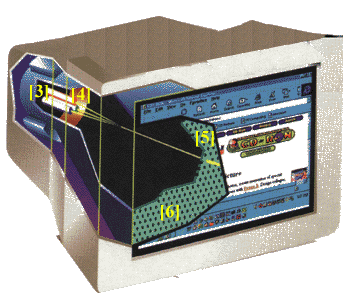CONTINUING PG NO : 1
 |
5]
The beams pass through holes in a metal plate called a shadow mask.
The purpose of the mask is to keep the elctron beams precisely
aligned with their targets on the inside of CRT's screen. The
CRT's dot pitch is the measurement of how close the holes are to
each other ; the closer the holes, the smaller the dot pitch.
This, in turn, creates a sharper image. The holes in most shadow masks
are arranged in triangles, with the important exception of those
of Sony Trinitron CRT used by many monitor manufacturers. The
Trinitrons's holes are arranged as parallel slots.
6] The electrons strike the phosphors coating the inside of the screen. Phophors are materials that glow when they are sturck by electrons. Three different phophor materials are used- one each for red,green, blue. The stronger the electron beam that bhits a phosphor, the more light the phosphor emits. If each red, green, and blue dot in an arrangement is struck by equally intense electron beams, the results is a dot of white light. |
To
create different colors, the intensity of each of the three beams is varied.
After a beam leaves a phosphor dot, the phosphor continues to glow
briefly, a condition called persistence. For an image to remain stable,
the phosphors must be reactivated by repeated scans of the electrons beams
before the persistence fades away.
7] After the beams make one horizantal sweep across the screen, the electron
streams are turned off as the electron guns refocus the path of the
beams back to the left edge of the screen at a point just below the previous
scan line. This process is called raster scanning.
8] The magnetic deflection yoke continually changes teh angles at which
the electron beams are bent so that they sweep across the entire
screen surface from the upper-left corner of the screen to the lower-right
corner. A complete sweep of the screen is called a field. Upon completing
a field, the beams return to the upper-left corner to begin a new
field. The screen is normally redrawn, or refreshed, about
60 times a second.
9] Some display adapter scan only every other line with each field, a
process called interlacing. Interlacing allows the adapter to create higher
resolution- that is, to scan more lines- with less expensive
components. But the fading of the phosphors between each pass can be noticeable,
causing the screen to flicker.